5. Haworthia blackburniae Barker, JS.Afr.Bot. 3:93(1937). Bayer :103(1976). Bayer :38(1986). Scott :2(1985). Type: Calitzdorp, Reynolds 1842 (NBG).
blackburniae: for Mrs H. Blackburn.
Roots fusiform. Rosette stemless, fibrous, 10-15mm φ at base, clumping. Leaves 10-15, long slender, to 400 X 1.5 to 5mm, channeled on the upper surface, margins glabrous or finely spined, colour bright green to brownish green or dark greyish green. Inflorescence simple raceme, to 300mm. Flowers white, green veined, 15-20.

a. var. blackburniae
The typical variety shows considerable variation over its range. The leaves may be very long and slender, or even be squat, short and with a tendency to flex downward and sideways. Leaf coloration bright green.
1982 – This is one of two unusual species with long slender canaliculate grass-like leaves, fibrous dry leaf bases, and thick fusiform roots. It is common in quartzitic rock in the Rooiberg mountains southeast of Calitzdorp and extending to about 32 km west of Ladismith. The full extent of its distribution and hence also its variability, is not known. Originally found growing singly and exposed, it generally prefers a cooler protected southern aspect where it forms dense clumps. In some forms the leaves are only 60 to 80mm long but as much as 3mm wide. In others the leaves may be 200mm or more long and only 2mm wide. H. blackburniae is very slow and difficult in cultivation. The Little Karoo is technically a summer rainfall area but with rainfall peaks in March and September/October. The hot dry summers discourage plant growth and many of the indigenous plants respond best to the cool wetter winters.
1999 – Many new collections have precipitated the decision to now include H. graminifolia here. H. blackburniae has in recent times been collected northeast of Calitzdorp as well as much further west in the Touwsberg and Anysberg. There are variants with more slender leaves which are toothed. Most significant is the collection by Jan Vlok in the De Rust area which is given varietal status here. Mention of the bluer-green coloration of the leaves of var. graminifolia was omitted from my previous discussions. This colour difference seems to be the only significant character which can really contribute to the decision to recognise three varieties. There is speculation about the affinities of this species. The fibrous nature of the stem as well as the broad insertion of the leaf onto the stem suggest a close relation with H. wittebergensis, which is very similar in these respects. This relationship is confirmed by Dr M. Hayashi (priv. comm.) on the basis of similar karyotypes. Interestingly Smith had, in his records, proposed a variety ladismithensis for plants collected southwest of Ladismith which flowered two months ahead of the Calitzdorp collections. Thus while flowering time is significant it may also vary quite dramatically within a species.
Distribution:
3320 (Montagu): Prinspoort (-BC), Bruyns (NBG). 3321 (Ladismith): W. Ladismith (-AC), Bayer in KG100/74 (NBG); Hartmansberg (-BC), Bruyns (NBG); SW. Ladismith (CA), Smith 5505 (NBG); Assegaaibos (-DA), Bayer 4429 (NBG); Rooiberg (-CB), Acocks 20395 (PRE); Rooiberg (-DA), Smith 2062 (NBG), Bayer 4428 (NBG); 12km SW. Calitzdorp (-DA), Blackburn in Reynolds 1842 (PRE); Calitzdorp (-DA), Blackburn in NBG1174/36 (NBG); Blackburn Valley (-DA), Barker 5094 (NBG, PRE) Warmbaths (-DB), Bayer in KG100/740 (NBG) Inadequately located: ex hort. Thudichum in NBG130/43 (NBG); Calitzdorp, Blackburn in BOL21933, Barker 5094 (BOL).



b. var. derustensis var.nov.
Type: CAPE-3222 (Oudtshoorn): West of De Rust (-BC), J. Vlok in J.D. Venter 93/24 (NBG, Holo.).
derustensis: from Derust.
Rosette robust, to 18mm φ. Leaves very long, to 450 X 3mm wide, brownish green at base, green above. (A H. blackburniae var. graminifolia foliis bruneo-viridibus validissimis et subtiliter striatis differt).
This variety was discovered by Jan Vlok east of Oudtshoorn in the De Rust area. It differs in that it is far more robust than the species, while the colour of the leaves has a brownish tinge and the leaves tend to be more erect. It occurs on the north upper slopes of conglomerate hills together with Euphorbia enopla. The brownish coloration is more pronounced in the old leaf bases. The seeds are surprisingly large. According to S. Hammer, the leaves of seedlings are characteristically striped. There is a difference in the flowers and the flowering time is also earlier than in the other two varieties. This robust variety also is a vigorous grower in contrast to the other two which are generally slow in cultivation.
Distribution:
3222 (Oudtshoorn): West of Derust (-BC), J. Vlok in Venter 93/24, (NBG).


c. var. graminifolia (Smith) Bayer (stat. nov.):
H. graminifolia Smith, JS.Afr.Bot. 8:247(1942). Bayer :120(1976). Bayer :40(1982). Scott :3(1985). Type: CAPE 3322(Oudtshoorn): Schoemanspoort ( AC), M. Courtenay Latimer in Smith 5222 (NBG).
graminifolia: grass like leaves.
1982 – When first collected, the plants were presumed to be a new species of Aloe and given to G.W. Reynolds. It was only when they flowered that they were seen to be a new Haworthia species. The leaves can be over 300 mm long but are seldom more than 1,5 mm wide. They are more channelled than is the case in H. blackburniae, and the margins are armed with minute white teeth. The leaf bases are amplexicaul and fibrous to papery not at all swollen or bulb like. The roots on the other hand are very thickened and fleshy. The narrow attachment to the stem is very easily broken or damaged and this must be guarded against when moving plants. H. graminifolia is only known in Schoemanspoort, north of Oudtshoorn. A smaller form has been reported on the rocky slopes above the Cango Caves, and collections have also reputedly been made from further west. Although separated from H. blackburniae on the basis of the narrower leaf and pronounced marginal teeth, this distinction may fail as the species becomes better known. H. graminifolia occurs on cooler, higher south slopes and is winter-growing. It is not as proliferous as H. blackburniae although J. Dekenah spoke of huge clumps overhanging the road between Oudtshoorn and the Cango Caves. This has never been confirmed, and H. graminifolia remains very scarce.
1999 – I have no indications that var. graminifolia is any commoner than I have suggested. The very slender leaves and their coloration were all that influenced the decision to maintain it earlier at species level. Leaf channeling is as much a characteristic in the typical variety, as is the presence of marginal leaf spines. Curiously I seem to have confounded the initial response to the collection of this variety by Miss Courtenay-Latimer. Scott I think correctly states that it was in fact H. blackburniae which was first considered to be an Aloe species. I clearly recall Miss Latimer also recounting her reaction to seeing the plant for the first time and her response was also to consider it an Aloe rather than an Haworthia. If she collected it in the absence of flowers, she must have indeed been very observant to have identified it among the many grass-like look-alikes, as being of interest to G.G. Smith. A collection by Peter Bruyns in the Gamkapoort is very similar to the original from Schoemanspoort, having perhaps a less blue coloration to the leaves, which are also slightly broader.
Distribution:
3321 (Ladismith): Hartmansberg (-BC), Bruyns sn. (BOL). 3322 (Oudtshoorn): Schoemanspoort ( AC), M. Courtenay Latimer in Smith 5222 (NBG).


